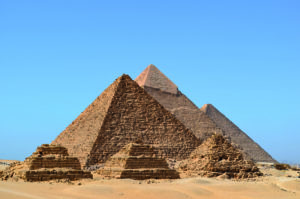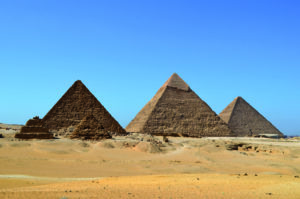An introduction to al Giza (Gizeh)
The three gigantic pyramids and the Sphinx in Giza (also called Gizeh) are mysterious and breathtaking world wonders built upon a slightly raised plateau on the edge of the Egyptian metropolis Cairo. Constructed with incredible precision, they are precisely aligned with the four cardinal points and specific planets, and are based on mathematical formulas and geometric shapes that remain astonishing today, even for modern science. Though contemporary Egyptologists attribute the building of these structures to the pharaohic dynasties (around 3,000 BC), there are many indications that they are essentially older, originating from a civilization before our time reckoning.
This panoramic view of Giza taken from the outskirts of Cairo (Misr) shows the vast scale of the pyramids and the Giza Plateau.
Todays academic literature still offers no credible explanation for how these ingenious buildings could have been constructed in the Egyptian era. Other sources, however, postulate that they were built by an even older, more advanced civilization that possessed greater knowledge. We will provide proof that this is indeed the truth: Both the pyramids at Giza and the Sphinx were built by the Atlanteans before the fall of Atlantis!
Inside and beneath the pyramids in Giza there are many more passages and buildings than have been previously discovered and officially reported by the Egyptologists. We were there ourselves and will provide detailed descriptions in this book. Construction of the above-ground structures began approximately 14,000 BC and ended around 1,000 years later. One section of the underground structure is even older and can be traced back to the Lemurians, an advanced civilization before the Atlanteans.
Builders unknown
Egyptologists tell us that the Giza Pyramids were built during the fourth Pharaohic Dynasty (Cheops, Chephren and Mykerinos) between 2550 and 2470 BC. If this is so, then the entire period must have been marked by the progress of these enormous construction projects. Yet, the recorded histories of the day fail to mention anything about who built the pyramids and how. Nor are there any writings or images that would indicate the existence of what would have been assumed to have been pompous funereal rites enacted upon the death of the three Pharaohs traditionally associated with the Giza Pyramids. Neither the artists nor the historians make any sort of reference to these purported major building feats of the pharaohic dynasties. While the few lists of royal dynasties handed down from the two millennium long pharaohic period through Cheops do contain the names of the kings of the fourth dynasty, none of them are ever mentioned in connection with the building of the Giza Pyramids. In comparison to the large ones built in Giza, the other pyramids in Egypt were built in a more amateurish style. While nothing but ruins remain of most of them, beneath the earth of some are found perfectly built megalithic chambers and monolithic sarcophagi, the origin of which have never been explained or even researched due the prevailing paradigm of contemporary Egyptology. The difference in quality between the Giza-like megalithic cores and the stone and shingle piles built on top of them is more than obvious throughout. It is all the more astonishing considering that the ancient Egyptians were extremely conservative and tended to maintain the things they constructed. Egypt grew to become a politically unified empire around 1,500 years before the era of Tutankhamen. Egypt was going through a period in which it was stuck in a cultural and societal morass from which it could not seem to rouse itself. Once a satisfactory procedure had been established in the arts, medicine or architecture it would never again be changed, States Christine El-Mahdy in her recommended book about Akhenaton, Nofret and Tutankhamen. It was perhaps the traditional nature of the Egyptians that would have enabled them to preserve the knowledge needed to build the Giza Pyramids. The latter Pharaohs would surely have used the same construction methods if they had been known to them. These outer casing stones weighed up to 16 tons. Despite their great weight, they were laid together with just 0.5 millimeters / 0.01 inch space between them. With its outer stone encasement, the volume of the Cheops pyramid comprised 2,592,968 cubic meters / 91,553,398 cubic feet, amounting to a total weight of around 7 million tons. While in older books the number of stone blocks is estimated to be around 2.6 million, newer calculations are closer to 2.3 million, because it was discovered that in the middle of the pyramid lies a stone core that is 7 meters / 23 feet tall. Considering that Cheops ruled for a maximum of twenty-five years, this would mean that throughout the time of his reign, it would have been necessary to lay 21 blocks per hour (12 hours a day, 365 days a year). If the contemporary assumption is used, which is that the main work periods were concentrated during the three months in which the Nile flooded, because the peasantry was then available for such honorary work, and the first ten years were used to build the infrastructure, such as the one-kilometer / .6 mile-route from the Nile to the 40-meter / 131-feet higher Giza Plateau, then the stone-laying tempo would have had to have been 141 stone blocks per hour to complete the Cheops pyramid within the pharaohs lifetime. And before they could be laid, they had to be transported to the site and cut into different sizes ranging from 5 – 15 tons. Many other challenges also beset this prevailing scenario, such as construction of the tools, importing wood to make the transport sleds (there was little wood to be found in Egypt) and the feeding and housing of the 100,000 workers described by the oldest surviving written records by the Greek historian Herodotus (484 to 425 BC). It would have required the cutting of the vast forested regions in Lebanon, Turkey and Northern Mesopotamia. The rapid wear to the wooden sleds under the enormous weight of the stones would have required the importing of millions of trees. Alone this massive volume of international trade should have left behind many records and documents. However, none have ever been found. These simple considerations show that there must be something wrong with the story we have been told of how the pharaohs built the pyramids. We will take a close look at the most remarkable features of the megalithic chambers within and beneath the 3 Giza Pyramids. That is where the nameless builders reveal the highest perfection of their skills.
This is an excerpt from the book GIZA LEGACY.



